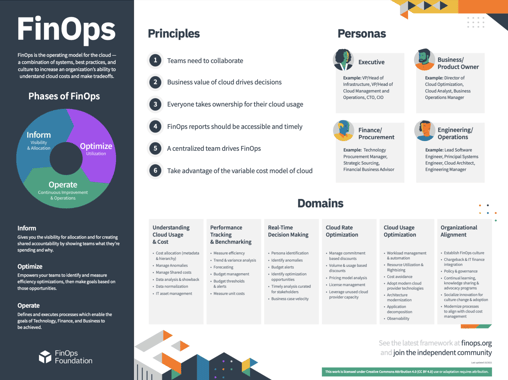What is FinOps and Where Did This Term Come From?
The FinOps Foundation defines FinOps as the “shorthand for Cloud Financial Operations or Cloud Financial Management or Cloud Cost Management”. It brings governance and financial accountability to the variable spend model for the cloud, enabling distributed teams to make business trade-offs between cost, quality and speed of deployment.
FinOps principles have been developed by members of the FinOps foundation and were originally included in the Cloud FinOps book in September 2019. They have since been adapted to cover multiple clouds and it is expected that these principles will evolve as new cloud experience is gained by members of the Foundation.
The Foundation has defined the domain model, phases, personas, capabilities and domains for FinOps.
But where did this practice come from? To many, the practice of expense and lifecycle management of a complex technology environment is far from new.
We have seen a natural evolution of expense management platforms like OneView as the IT landscape of an enterprise changed. Over the last 30 years, as the majority of enterprise and corporate companies rolled out telephony infrastructure, often with multiple service providers, it became essential to adopt telecoms expense management systems and practices. This practice naturally expanded to include additional technologies beyond telephony and mobile to data centre hosting, networking and security, and managed services and software licensing. As these costs became more fragmented across different service providers the billing became increasingly complex and so did the cost management function, the most complex of which being the consumption and seat-based billing models adopted by more and more services offered by License Service Providers (LSPs), Managed Service Providers (MSPs), System Integrators (SI) and SaaS providers.
Today, most enterprise and corporate companies have an established IT cost management function that is often supported by a Technology Expense Management platform or TEM managed service. This function is traditionally filled with team members with a financial or accounting background and have to rely on the support of their IT counterparts or trusted independent advisors to support them on decoding these complex service provider bills.
Now enter the private and public cloud services. This internal IT cost management function has needed to start layering on the Cloud and SaaS services into their financial processes of budgeting, forecasting and reporting and charge-backs. These costs are often not immediately visible as they are often included in the existing, already substantial, license agreements from related LSPs and MSPs or, worst of all, are spread throughout the business and not centralised in IT.
This is only the start of this trend for many companies. According to Gartner (2021), public cloud spending will exceed 45% of all enterprise IT spending by 2026, up from less than 17% in 2021. This means that the challenges we face in controlling and optimising these costs are here to stay and will become ever more critical to manage. In 2021 SaaS and PaaS services make up more than 60% of the cloud spend and is projected to outpace the growth of IaaS, according to the same Gartner study, compounding the potential challenges companies will face to manage these costs as they are the more complex to budget and forecast.
How Can Adopting the Practice of FinOps Help?
As the name implies, the FinOps practice lays out an operating model for the most efficient way for companies to manage their private and public cloud costs. In the adopting FinOps guide, the team members and roles needed to gain financial and operational control over your cloud spend are outlined and summarised really well in this infographic:
Source: https://www.finops.org/img//resources/FinOps%20Poster_011021.pdf
What Must you do Next?
The FinOps foundation has put a number of great resources together to find out more on the topic and these are highly recommended for anyone on the cloud journey:
- Your Business Operating Manual for the Cloud. https://www.finops.org/resources/finops-book/
- How to Jump Start FinOps in your Organization. https://www.finops.org/projects/adopting-finops/
Additional Sources:
- Gartner. (2021, August 2). Gartner Says Four Trends Are Shaping the Future of Public Cloud. Retrieved from www.gartner.com: https://www.gartner.com/en/newsroom/press-releases/2021-08-02-gartner-says-four-trends-are-shaping-the-future-of-public-cloud
For 1Nebula, Technology Expense Management remains a core focus to offer a smarter way to manage and control your telecoms, technology and cloud costs. Get in touch with us to find out how we can help!

